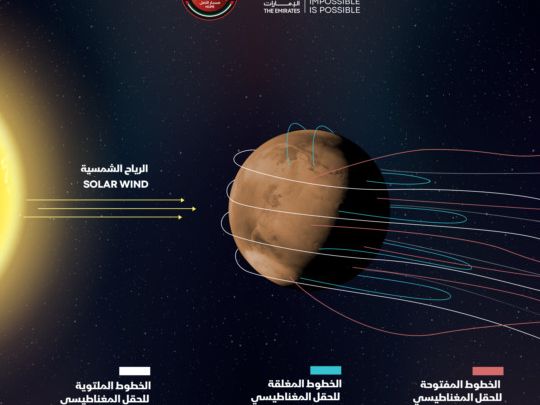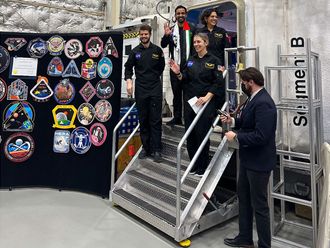
Dubai: New images of glowing atmospheric lights over Mars, known as discrete auroras, were released by Emirates Mars Mission (EMM) today.
The pictures were taken by the orbiting Hope Probe, following “a new series of revolutionary observations that promise new answers — and new questions — about the interactions between Mars’ atmosphere, the planet’s magnetic fields and its solar wind”.
Dubbed ‘sinuous discrete aurora’ by the EMM team, the phenomenon is described as “a huge worm-like aurora that extends halfway around the planet”.
“The sinuous discrete aurora consists of long worm-like streaks of energised electron emission in the upper atmosphere, extending many thousands of kilometres, stretching from the dayside into the nightside of Mars,” the EMM statement added. “(The pictures) were taken when Mars was experiencing the effect of a solar storm, resulting in a faster, more turbulent stream of solar wind electrons than usual. These aurora observations are some of the brightest and most extensive yet captured by the Hope Probe. They include elongated shapes, which may be caused by similarly elongated regions of electron energisation conditions in the magnetotail,” the team added.
‘Ghostly glow’
An aurora — which looks like a ghostly glow — is a natural phenomenon characterised by a display of a natural-coloured (green, red, yellow or white) light show. It occurs when electrically-charged particles from the sun collide with particles from gases such as oxygen and nitrogen present in the atmosphere. A type of Martian aurora first identified by Nasa’s MAVEN spacecraft in 2016 is actually the most common form of aurora occurring on the Red Planet. According to scientists, the aurora can help them track water loss from Mars’ atmosphere.
The images taken by Hope Probe have revolutionary implications for understanding the interactions between solar radiation and its Martian magnetic fields as well as the planetary atmosphere.
Focus on auroras
Hessa Al Matroushi, the EMM Science Lead, said: “When we first imaged Mars’ discrete aurora, shortly after the Hope probe’s arrival on Mars in 2021, we knew we had unveiled new potential to make observations never before possible on this scale, and we took the decision to increase our focus on these auroras. We can obtain nearly whole-disk, synoptic snapshots of the atmosphere to investigate atmospheric phenomena and interactions. It means we are seeing discrete auroral effects on a massive scale and in ways we never anticipated,” she added.
Al Matroushi explained that the interplanetary magnetic field is carried by the solar wind and drapes around Mars, combining with magnetism in the Martian crust to form Mars’ magnetotail — a complex array of magnetic fields on the Martian nightside.
Dynamic phenomena
Omran Sharaf, EMM project director, was elated with the new discoveries. He said: “Having additional bandwidth and resources available to us meant we could be opportunistic and focus more on the area of discrete auroras than we had originally planned. That agility has certainly paid off as we have now opened up whole new avenues of investigation into these transient and dynamic phenomena. Novel science was a core mission objective and this is certainly novel.”
Dr Rob Lillis, EMUS (Emirates Mars Ultraviolet Spectrometer) team member at the University of California, Berkeley, said: “The sinuous discrete aurora was a shocking discovery that in many ways has us scratching our heads and going back to the drawing board. We have ideas, but no solid explanation for why we are observing intense aurora of this shape and at planetary scales. We now have the opportunity to re-examine prior observations of Mars by missions such as MAVEN and Mars Express to search for signatures that could flesh out Hope Probe’s new observations and perhaps help us try and unpick what is happening here,” he added.

How the pictures were taken
Mars observations were made using Hope Probe’s EMUS instrument, with a range between 90-180 nanometre wavelengths. Found at a wavelength of 130.4nm, the UV (ultraviolet) emissions imaged in the new set of observations show energetic electrons smashing into atoms and molecules in the Martian upper atmosphere, some 130km above the planetary surface.
The electrons come from the solar wind and are energised by electric fields in Mars’ magnetosphere (region dominated by the planet’s magnetic field).
Novel science
Three types of aurora had previously been identified, but clear global images of the discrete aurora were elusive until new observations were made by Hope Probe shortly after its arrival on Mars last year.
Now, an increased focus on discrete aurora observations by the EMM science team has resulted in observations of this new phenomenon of sinuous discrete aurora.
Hope Probe is also measuring oxygen and carbon monoxide in Mars’ thermosphere and the variability of hydrogen and oxygen in the exosphere. Its overall mission is to study the Martian atmosphere and the relationship between the upper layer and lower regions and, for the first time, give the international science community full access to a holistic view of the Martian atmosphere at different times of the day, through different seasons.
EMM noted that science data releases have been taking place every three months, with the information made freely accessible globally to researchers and enthusiasts.










